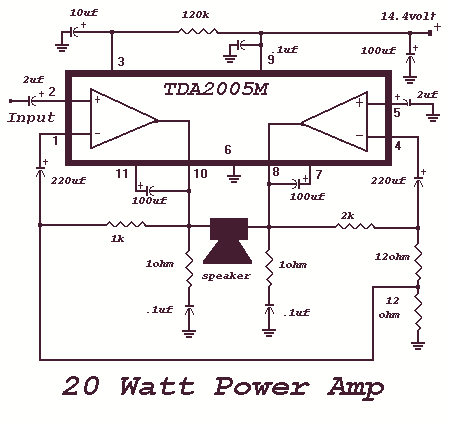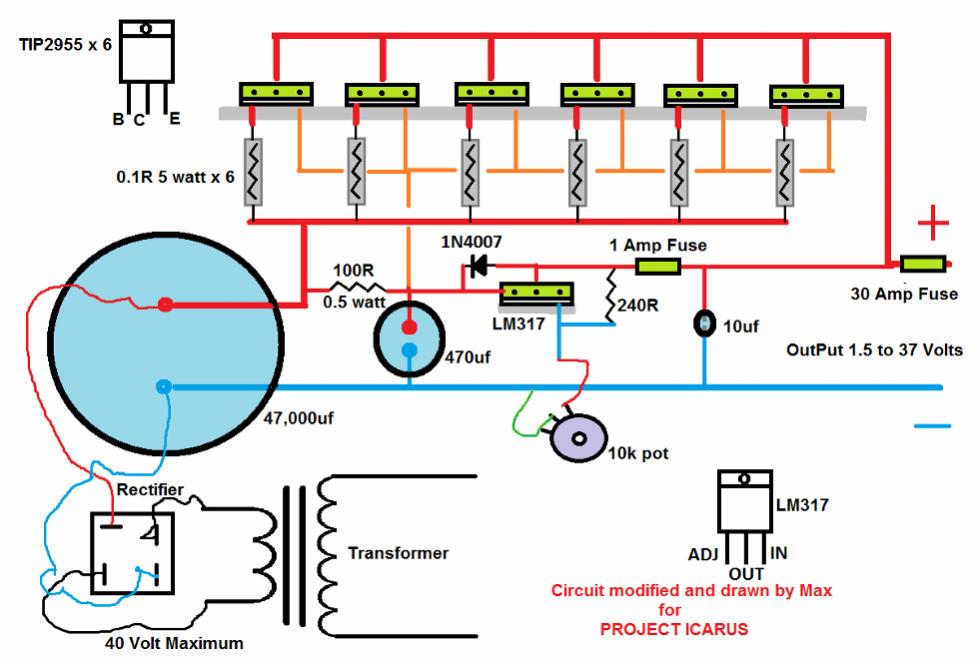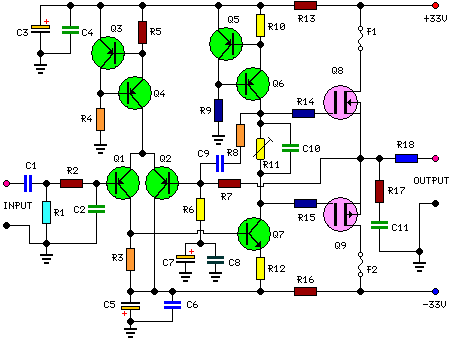
20 Watt Power Amplifier with TDA2005

This IC chip was designed specifically for use in power boosting applications in automobiles. It is self protecting against short circuits and thermal problems. In the bridge configuration shown it will deliver 20 watts of power into a 2 ohm speaker operating at 14.4 volts.
The integrated circuit (IC) chip referenced is optimized for automotive power amplification, making it suitable for driving speakers in vehicle audio systems. The design incorporates advanced protection mechanisms, allowing it to withstand short circuits and prevent thermal overload, which enhances reliability in automotive environments where conditions can be variable and demanding.
In a bridge configuration, this IC can efficiently deliver an output power of 20 watts into a load of 2 ohms. The bridge configuration typically involves connecting two amplifying devices in such a way that they drive the speaker with opposite phases of the input signal, effectively doubling the output voltage across the speaker. This configuration not only maximizes power output but also improves the overall efficiency of the audio system.
The operational voltage of 14.4 volts is standard for automotive applications, as it corresponds to the nominal voltage of a vehicle's electrical system when the engine is running. This makes the IC suitable for direct integration into automotive audio systems without the need for additional voltage regulation components.
To ensure optimal performance, the circuit design should include appropriate filtering capacitors to stabilize the power supply and minimize noise. Additionally, heat dissipation mechanisms, such as heat sinks or thermal pads, should be implemented to manage the heat generated during operation, especially at higher output levels.
Overall, this IC chip represents a robust solution for enhancing audio performance in automotive applications, combining power efficiency with protective features essential for reliability in mobile environments.This IC chip was designed specifically for use in power boosting applications in automobiles. It is self protecting against short circuits and thermal problems. In the bridge configuration shown it will deliver 20 watts of power into a 2 ohm speaker operating at 14.4 volts. 🔗 External reference
The integrated circuit (IC) chip referenced is optimized for automotive power amplification, making it suitable for driving speakers in vehicle audio systems. The design incorporates advanced protection mechanisms, allowing it to withstand short circuits and prevent thermal overload, which enhances reliability in automotive environments where conditions can be variable and demanding.
In a bridge configuration, this IC can efficiently deliver an output power of 20 watts into a load of 2 ohms. The bridge configuration typically involves connecting two amplifying devices in such a way that they drive the speaker with opposite phases of the input signal, effectively doubling the output voltage across the speaker. This configuration not only maximizes power output but also improves the overall efficiency of the audio system.
The operational voltage of 14.4 volts is standard for automotive applications, as it corresponds to the nominal voltage of a vehicle's electrical system when the engine is running. This makes the IC suitable for direct integration into automotive audio systems without the need for additional voltage regulation components.
To ensure optimal performance, the circuit design should include appropriate filtering capacitors to stabilize the power supply and minimize noise. Additionally, heat dissipation mechanisms, such as heat sinks or thermal pads, should be implemented to manage the heat generated during operation, especially at higher output levels.
Overall, this IC chip represents a robust solution for enhancing audio performance in automotive applications, combining power efficiency with protective features essential for reliability in mobile environments.This IC chip was designed specifically for use in power boosting applications in automobiles. It is self protecting against short circuits and thermal problems. In the bridge configuration shown it will deliver 20 watts of power into a 2 ohm speaker operating at 14.4 volts. 🔗 External reference
.gif)




